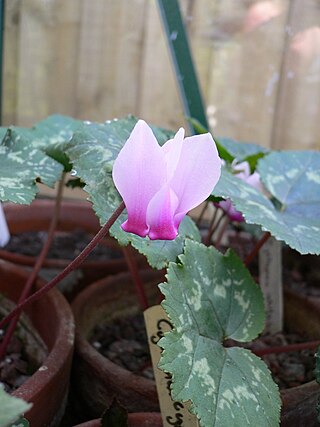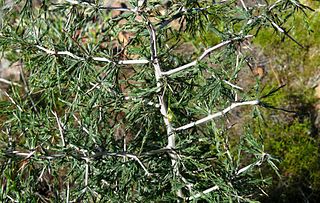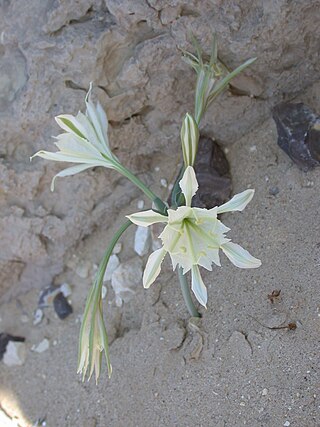
Crinum is a genus of about 180 species of perennial plants that have large showy flowers on leafless stems, and develop from bulbs. They are found in seasonally moist areas, including marshes, swamps, depressions and along the sides of streams and lakes in tropical and subtropical areas worldwide.

Luzula is a genus of flowering plants in the rush family Juncaceae. The genus has a cosmopolitan distribution, with species occurring throughout the world, especially in temperate regions, the Arctic, and higher elevation areas in the tropics. Plants of the genus are known commonly as wood-rush, wood rush, or woodrush. Possible origins of the genus name include the Italian lucciola or the Latin luzulae or luxulae, from lux ("light"), inspired by the way the plants sparkle when wet with dew. Another etymology sometimes given is that it does derive from lucciola but that this meant a mid-summer field, or from the Latin luculus, meaning a small place; the same source also states that this name was applied by Luigi Anguillara in 1561.

Myrica is a genus of about 35–50 species of small trees and shrubs in the family Myricaceae, order Fagales. The genus has a wide distribution, including Africa, Asia, Europe, North America and South America, and missing only from Australia. Some botanists split the genus into two genera on the basis of the catkin and fruit structure, restricting Myrica to a few species, and treating the others in Morella.

Spergularia is a genus in the family Caryophyllaceae, containing salt-tolerant plants known as sandspurrys and sea-spurreys. There are about 60 species.
Aegilops kotschyi is a member of the grass family, Poaceae, native to the Levant.
Amphibolis antarctica is a species of flowering plant in the family Cymodoceaceae. It is referred to by the common names wire weed or sea nymph, and is a seagrass found in coastal waters of southern and western Australia.

Zizaniopsis is a genus of plants in the grass family, Poaceae, native to North and South America.

Periballia is a genus of Mediterranean plants in the grass family.

Cyclamen rohlfsianum is a species of perennial plant in the family Primulaceae. It is endemic to Libya. It grows from a tuber in shrubland, especially in limestone cracks, up to 450 m (1,500 ft) above sea level. It is one of the tenderest cyclamen species. The plant was discovered by Friedrich Gerhard Rohlfs in 1879, and was named after him in 1897 by Paul Friedrich August Ascherson.

Moraea aristata is a species of flowering plant in the family Iridaceae. It is referred to by the common names blue-eyed uintjie or Blouooguintjie in Afrikaans.It is endemic to the city of Cape Town and is considered to be critically endangered.

Asparagus lignosus ("Katdoring") is a thorny, spindly creeper of the Asparagus genus, that is indigenous to the Western Cape Province of South Africa.
Canarina eminii is a species of flowering plant in the family Campanulaceae. It is an epiphytic or terrestrial, usually glaucous, herb. Its root is thick, often with a corky surface layer. Its stems are erect and scandent, pendent up to several meters in length, usually with a fine purplish mottling. Its leaves are triangular to ovate, up to 10 cm long, acute with cordate to cuneate base, dentate, double dentate or double serrate. Its corollas are funnel-shaped to 7.5 cm long, orange to orange-red with darker venation.

Zea luxurians, also referred to by the common names Maíz de Monte, Florida teosinte and Guatemalan teosinte, is a species of flowering plant in the family Poaceae. It is a true grass and a teosinte.

Pancratium sickenbergeri is a species of flowering plant in the Amaryllidaceae family. It is a Saharo-Arabian plant that grows in deserts, such as the Negev. It is native to Israel, Egypt, Lebanon, Palestine, Saudi Arabia, and Syria. The flowers look like the Mediterranean species Pancratium maritimum, but the leaves of P. sickenbergeri are curly and the plant is much smaller. Unusually for the desert, the seeds are distributed by floodwaters when they occur in the winter.
Halophila baillonis is a species of aquatic plant in the family Hydrocharitaceae. It is referred to by the common name clover grass. It is native to Brazil, Cayman Islands, Colombia, Costa Rica, Jamaica, Leeward Islands, Netherlands Antilles, Panama, Puerto Rico, Trinidad and Tobago, and Venezuela. It is listed on the IUCN Red List as "vulnerable" due to its naturally rare occurrence and fragmented populations.
Althenia australis is a species of aquatic plant in the family Potamogetonaceae. It is found in fresh to brackish waters in Australia. This species has been transferred from Lepilaena.

Althenia preissii is a plant found in fresh to brackish waters in Australia. This species has been transferred from the genus Lepilaena.
Sesamum schinzianum is a species of flowering plant in the Pedaliaceae family.
Karl Otto von Seemen was a German botanist and horticulturalist. He is noted for his studies of plants in the south of Africa.











